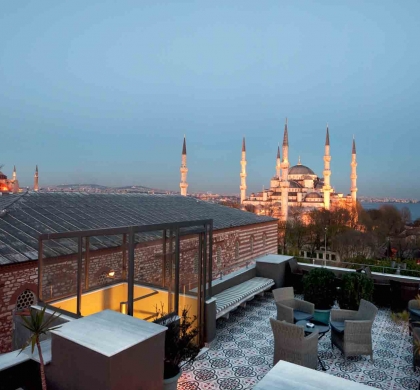Buy or gift a stand-alone digital subscription and get unlimited access to dozens of back issues for just £18.99 / $18.99 a year.
Please register at www.exacteditions.com/digital/cornucopia with your subscriber account number or contact subscriptions@cornucopia.net
Buy a digital subscription Go to the Digital EditionRupert Scott reviews The Ottomans: A legacy, Diana Darke’s celebration of all aspects of an Ottoman culture that has now largely ceased to exist.
To appreciate Ottoman society, there is nowhere better to start than the superbly produced and illustrated The Ottomans: A Cultural Legacy by Diana Darke. This is a celebration of all aspects of Ottoman culture – its government, religious values, commerce, education, art, medicine, music, architecture and cuisine.
If a book was ever a joy not just to read but to look at, this is it. Every page seems to hold not only another fascinating revelation, but also a beautiful illustration to go with it. The author has a deep understanding of Ottoman society and has travelled widely throughout what was the Ottoman Empire. She explains how that society worked and why it endured so long, and how it was frequently misrepresented and misunderstood by Western European societies; and she believes there is much to learn from it today.
Diana Darke sees religious tolerance and an ability to absorb from other societies as key to Ottoman success, but above all she believes it was Ottoman egalitarianism that explains that society’s remarkable longevity. She cites the development of Bursa, the first Ottoman capital, which was a city planned around the needs of a community. Under the külliye system, with the mosque at its heart, funds from a range of profitable activities such as the hamam and the market supported mosques, schools, hostels, clinics, almshouses and soup kitchens. It is a system that has proved enduring. At the Muradiye complex in Bursa, completed in 1426, most of the buildings are still in use but have been adapted to modern needs. The Ottoman public kitchen is now a restaurant, whereas the hamam is a centre for the disabled.
Another practice that Darke sees as critical to explaining Ottoman success is the devşirme system, under which males between the ages of 15 and 18 were recruited from towns and villages every few years to form a source of future soldiers and administrators. Shorn of family and tribal loyalties and promoted on merit, the products of this system became capable officers and functionaries; a notable example being Rüstem Pasha, a Catholic Croat from near Sarajevo who rose to become Süleyman the Magnificent’s longest-serving grand vizier and married his only daughter, Mihrimah Sultan, in 1539. The great 16th-century court architect Sinan was another product of devşirme. Sinan was the great polymath of his age, an engineer and architect of genius and an Ottoman parallel to great figures of the Western Renisassance such as Brunelleschi, Michelangelo or Leonardo.
In the chapter “The Commercial Spirit” there are fascinating statistics about the role of women in business in Ottoman society, which will challenge many Western preconceptions. For instance, in 1678 women in Bursa owned about half of the silk reeling and twisting equipment and were clearly independent agents rather than appendages of their husbands’ enterprises. In Aleppo in the mid-1700s women constituted up to one third of all commercial property buyers and investors. This suggests that in some ways Ottoman women were more empowered than women in parts of Western Europe, where they acquired property rights remarkably late. In England, for instance, the Married Women’s Property Act was passed only in 1870. Before that date, a married woman’s property was automatically controlled by her husband. In the chapter “Medical Mores” it is also surprising to read that women were involved in Ottoman medicine from an early date and that women were the chief practitioners of vaccination.
This book is full of unexpected gems of information. For instance, that Giuseppe Donizetti (elder brother of the more famous Gaetano Donizetti) held a position at the Ottoman court as Instructor General of Imperial Music from 1828 to 1856. Ladies of the harem learnt to play the piano on instruments imported from Vienna and members of the Imperial family even began composing their own polkas, marches and waltzes. Giuseppe Donizetti is buried in the vault of the St Esprit cathedral in Pera.
In her rather sombre conclusion the author reflects on modern life in the post-Ottoman world. She regrets the decline of religious coexistence and of the speaking of other communities’ languages, which was such a vital part of Ottoman life, and she regrets the tendency to neglect and ignore the Ottoman past in some Balkan countries.
But on a more positive note she cites modern Sarajevo and Prizren as vibrant places with functioning mosques, churches and synagogues in close proximity where the Ottoman legacy can still be seen. And she finds echoes of the Ottoman past in the generous response of Turkey, Lebanon and Jordan to the displacement of more than half of Syria’s population of 23 million people. Turkey alone has offered asylum to 3.6 million Syrians, something very much in the spirit of an Ottoman past in which she finds much to admire.
Istanbul, newly distilled in cool monochrome: the photographs of Annette Louise Solakoğlu
Once the staple food of nomads and warriors, pastırma has turned into a gourmet delicacy. Text and photographs by Berrin Torolsan
In the cave cellars of Cappadocia, Udo Hirsch and Hacer Özkaya are reinventing ancient ways with wine.
Briony Llewellyn and Charles Newton on a rediscovered portrait by JF Lewis
Nick Thorpe pays tribute to a friend and the much-loved author of Cornucopia’s ‘Letter from Anatolia’
A must for stylish travellers, the Ottoman document case carried state secrets as well as intimate messages. A show of these covetable objects at the Sadberk Hanım Museum captivates Philip Mansel
The birds are flocking back to İzmir’s Gediz Delta
Off the beaten track in Anatolia with Don McCullin





Cornucopia works in partnership with the digital publishing platform Exact Editions to offer individual and institutional subscribers unlimited access to a searchable archive of fascinating back issues and every newly published issue. The digital edition of Cornucopia is available cross-platform on web, iOS and Android and offers a comprehensive search function, allowing the title’s cultural content to be delved into at the touch of a button.
Digital Subscription: £18.99 / $18.99 (1 year)
Subscribe now